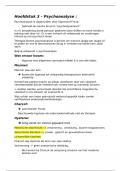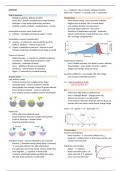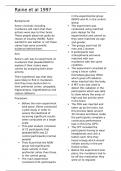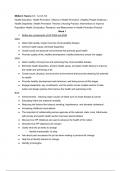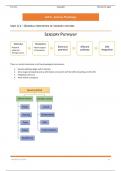Week 6:
Preparation: Chapter 13: The Open Economy revisited: The
Mundell-Fleming
Model and the Exchange-Rate Regime
The Mundell-Fleming Model: “the dominant policy paradigm for studying open-
economy monetary and fiscal policy”. Makes the important assumption that the
economy being studied is a small open economy with perfect capital mobility.
=> The economy can borrow and lend as much as it wants in world financial
markets and, as a result, the economy’s interest rate is determined by the world
interest rate.
r = r* thanks to the rapidness of the international flow of capital
Y = C(Y – T) + I(r) + G + NX(e) Recall : = eP/ P*
IS* curve defined by : Y = C(Y – T) + I(r*) + G + NX(e)
M/P supply of the money balance= L(r, Y) Demand
LM* curve is defined by : M/P = L(r*, Y)
System of Floating exchange rates: the exchange rate is set by market forces
and is allowed to fluctuate in response to changing economic conditions.
3 policies can change the equilibrium:
- Fiscal Policy: When gov increases spending or cut taxes, the appreciation
of the currency and the fall in net exports must be large enough to fully
offset the expansionary effect of the policy on income.
- Monetary Policy: Influences income by altering the exchange rate rather
than the interest rate.
- Trade Policy: because a trade restriction doesn’t affect any factor, it
doesn’t affect the trade balance. The overall effect is just less trade: less
imports & exports.
Fixed exchange rates: the central bank announces a value for the exchange rate
and stands ready to buy and sell the domestic currency to keep the exchange
rate at its announced level.
Dedicates a country’s monetary policy to the single goal of keeping the
exchange rate at the announced level. As long as the CB stands ready to
buy or sell foreign currency at the fixed exchange rate, the money supply
adjusts automatically to the necessary level.
The exchange rate system fixes the nominal exchange rate.
A country with a fixed exchange rate can conduct a type of monetary policy: it
can decide to change the level at which the exchange rate is fixed. A reduction
in the official value of the currency is called a devaluation (shifting LM* to the the
right), and an increase a revaluation (shifting LM* to the left).
NX = S – I
Differential:
Consider the risk premium: r = r* +
Then IS*: Y = C(Y – T) + I(r* + ) + G + NX(e)
, Then LM*: M/P = L(r* + , Y)
The expectation that a currency will lose value in the future causes it lose value
today.
Speculative attack: a change in investors’ perceptions that makes the fixed
exchange rate untenable.
Currency board: arrangement by which the CB holds enough foreign currency to
back each unit of the domestic currency.
Dollarization: Happens where foreign currencies offer a more reliable store of
value than the domestic currency.
It is impossible for a country to have a free capital flows, a fixed exchange rate
and independent monetary policy. => Impossible trinity or trilemma of
international finance.
Lecture:
The Mundell-Fleming model
Mundell and Fleming:
Short run -> P exogenous
Combine the Keynesian Cross model with the Liquidity Preference model.
Focus on equilibrating forces in the goods and money markets (in a small
economy: Y and e)
Preparation: Chapter 13: The Open Economy revisited: The
Mundell-Fleming
Model and the Exchange-Rate Regime
The Mundell-Fleming Model: “the dominant policy paradigm for studying open-
economy monetary and fiscal policy”. Makes the important assumption that the
economy being studied is a small open economy with perfect capital mobility.
=> The economy can borrow and lend as much as it wants in world financial
markets and, as a result, the economy’s interest rate is determined by the world
interest rate.
r = r* thanks to the rapidness of the international flow of capital
Y = C(Y – T) + I(r) + G + NX(e) Recall : = eP/ P*
IS* curve defined by : Y = C(Y – T) + I(r*) + G + NX(e)
M/P supply of the money balance= L(r, Y) Demand
LM* curve is defined by : M/P = L(r*, Y)
System of Floating exchange rates: the exchange rate is set by market forces
and is allowed to fluctuate in response to changing economic conditions.
3 policies can change the equilibrium:
- Fiscal Policy: When gov increases spending or cut taxes, the appreciation
of the currency and the fall in net exports must be large enough to fully
offset the expansionary effect of the policy on income.
- Monetary Policy: Influences income by altering the exchange rate rather
than the interest rate.
- Trade Policy: because a trade restriction doesn’t affect any factor, it
doesn’t affect the trade balance. The overall effect is just less trade: less
imports & exports.
Fixed exchange rates: the central bank announces a value for the exchange rate
and stands ready to buy and sell the domestic currency to keep the exchange
rate at its announced level.
Dedicates a country’s monetary policy to the single goal of keeping the
exchange rate at the announced level. As long as the CB stands ready to
buy or sell foreign currency at the fixed exchange rate, the money supply
adjusts automatically to the necessary level.
The exchange rate system fixes the nominal exchange rate.
A country with a fixed exchange rate can conduct a type of monetary policy: it
can decide to change the level at which the exchange rate is fixed. A reduction
in the official value of the currency is called a devaluation (shifting LM* to the the
right), and an increase a revaluation (shifting LM* to the left).
NX = S – I
Differential:
Consider the risk premium: r = r* +
Then IS*: Y = C(Y – T) + I(r* + ) + G + NX(e)
, Then LM*: M/P = L(r* + , Y)
The expectation that a currency will lose value in the future causes it lose value
today.
Speculative attack: a change in investors’ perceptions that makes the fixed
exchange rate untenable.
Currency board: arrangement by which the CB holds enough foreign currency to
back each unit of the domestic currency.
Dollarization: Happens where foreign currencies offer a more reliable store of
value than the domestic currency.
It is impossible for a country to have a free capital flows, a fixed exchange rate
and independent monetary policy. => Impossible trinity or trilemma of
international finance.
Lecture:
The Mundell-Fleming model
Mundell and Fleming:
Short run -> P exogenous
Combine the Keynesian Cross model with the Liquidity Preference model.
Focus on equilibrating forces in the goods and money markets (in a small
economy: Y and e)


